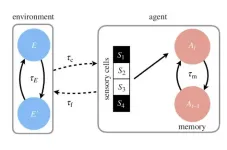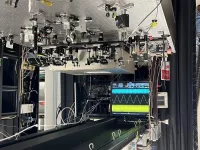(Press-News.org) BIRMINGHAM, Ala. – A long-standing goal of neuroscience is to understand how molecules and cellular structures on a microscale give rise to communication between brain regions at the macroscale. A study published in Nature Neuroscience now identifies, for the first time, hundreds of brain proteins that explain inter-individual differences in functional connectivity and structural covariation in the human brain.
“A central goal of neuroscience is to develop an understanding of the brain that ultimately describes the mechanistic basis of human cognition and behavior,” said Jeremy Herskowitz, Ph.D., associate professor in the University of Alabama at Birmingham Department of Neurology and co-corresponding author of the study with Chris Gaiteri, Ph.D., SUNY Upstate Medical University, Syracuse, New York. “This study demonstrates the feasibility of integrating data from vastly different biophysical scales to provide a molecular understanding of human brain connectivity.”
Bridging the gap from the molecular scale of proteins and mRNA to the brain-wide neuroimaging scale of functional and structural magnetic resonance imaging — a span of about seven orders of magnitude — was made possible by the Religious Orders Study and Rush Memory and Aging Project, or ROSMAP, at Rush University, Chicago, Illinois.
ROSMAP enrolls Catholic nuns, priests and brothers age 65 or older, who are without known dementia at time of enrollment. Participants receive medical and psychological evaluations each year and agree to donate their brains after death.
Herskowitz, Gaiteri and colleagues studied postmortem brain samples and data from a unique cohort of 98 ROSMAP participants. Their data types included resting state fMRI, structural MRI, genetics, dendritic spine morphometry, proteomics and gene expression measurements from the superior frontal gyrus and inferior temporal gyrus of the brain.
“Based on the stability of functional connectivity patterns within individuals, we hypothesized that it is possible to combine postmortem molecular and subcellular data with antemortem neuroimaging data from the same individuals to prioritize molecular mechanisms underlying brain connectivity,” Herskowitz said.
The average age of the ROSMAP participants at time of MRI scan and at death were 88 +/- 6 years and 91 +/- 6 years, respectively, with an average time interval between the MRI scan and age at death of 3 +/- 2 years. The average postmortem interval to brain sampling was 8.5 +/- 4.6 hours. In the study, the researchers performed detailed characterization of each omic, cellular and neuroimaging data type, then integrated the different data types using computational clustering algorithms.
The key to the research was using an intermediate scale measurement — dendritic spine morphometry, the shapes, sizes and densities of the spines — to link the molecular scale with the brain-wide neuroimaging scale. The integration of dendritic spine morphometry to contextualize the proteomic and transcriptomic signals was critical for detecting protein association with functional connectivity. “Initially, the protein and RNA measures could not explain the person-to-person variability in functional connectivity; however, it all clicked once we integrated the dendritic spine morphology to bridge the gap from molecules to inter-brain region communication,” Herskowitz said.
A dendrite is a branched extension from a neuron body that receives impulses from other neurons. Each dendrite can have thousands of small protrusions called spines. The head of each spine can form a contact point called a synapse to receive an impulse sent from the axon of another neuron. Dendritic spines can rapidly change shape or volume while forming new synapses, part of the process called brain plasticity, and the head of the spine structurally supports postsynaptic density. Spines can be divided into shape subclasses based on their three-dimensional structure as thin, mushroom, stubby or filopodia. This summer, in a different study, Herskowitz and colleagues used ROSMAP samples to show that preservation of memory in the very old was maintained by the quality, as measured by dendritic spine head diameter, not the quantity of synapses in the brain.
In this latest study, the hundreds of proteins the researchers identified that explain inter-individual differences in functional connectivity and structural covariation were enriched for proteins involved in synapses, energy metabolism and RNA processing. “By integrating data at the genetic, molecular, subcellular and tissue levels, we linked specific biochemical changes at synapses to connectivity between brain regions,” Herskowitz said.
“Overall, this study indicates that acquiring data across the major perspectives in human neuroscience from the same set of brains is foundational for understanding how human brain function is supported at multiple biophysical scales,” Herskowitz said. “While future research is necessary for fully determining the scope and components of multi-scale brain synchrony, we have established a robustly defined initial set of molecules whose effects likely resonate across biophysical scales.”
Besides Herskowitz and Gaiteri, co-authors of the study, “Multiscale Integration Identifies Synaptic Proteins Associated with Human Brain Connectivity,” are Bernard Ng, Shinya Tasaki and David A. Bennett, Rush University Medical Center, Chicago, Illinois; Kelsey M. Greathouse, Courtney K. Walker, Audrey J. Weber, Ashley B. Adamson, Julia P. Andrade, Emily H. Poovey, Kendall A. Curtis and Hamad M. Muhammad, UAB Department of Neurology and Center for Neurodegeneration and Experimental Therapeutics; Ada Zhang, SUNY Upstate Medical University; Sydney Covitz, Matt Cieslak, Jakob Seidlitz, Ted Satterthwaite and Jacob Vogel, University of Pennsylvania, Philadelphia, Pennsylvania; and Nicholas T. Seyfried, Emory University School of Medicine, Atlanta, Georgia.
Support came from National Institutes of Health grants AG061800, AG061798, AG057911, AG067635, AG054719, AG063755, AG068024, NS061788, AG10161, AG72975, AG15819, AG17917, AG46152 and AG61356.
At UAB, Neurology is a department in the Marnix E. Heersink School of Medicine.
END
Human proteins identified that explain inter-individual differences in functional brain connectivity
This is a step toward an understanding of the brain that ultimately describes the mechanistic basis of human cognition and behavior
2024-10-31
ELSE PRESS RELEASES FROM THIS DATE:
A newly developed algorithm shows how a gene is expressed at microscopic resolution
2024-10-31
They say a picture is worth a thousand words.
A new method, developed by University of Michigan researchers, creates images that are worth many gigabytes of data, which could revolutionize the way biologists study gene expression. Seq-Scope, developed by Jun Hee Lee, Ph.D., Hyun Min Kang, Ph.D., and their colleagues, was first described in Cell in 2021 as the first method to analyze gene expression at sub micrometer-scale spatial resolution.
To compare, a single human hair ranges from 20 to 200 micrometers in width.
The team has since improved Seq-Scope, making it more versatile, ...
Why elephants never forget but fleas have, well, the attention span of a flea
2024-10-31
Researchers at the Complexity Science Hub and Santa Fe Institute have developed a model to calculate how quickly or slowly an organism should ideally learn in its surroundings. An organism’s ideal learning rate depends on the pace of environmental change and its life cycle, they say.
Every day, we wake to a world that is different, and we adjust to it. Businesses face new challenges and competitors and adapt or go bust. In biology, this is a question of survival: every organism, from bacteria to blue whales, faces the challenge of adapting to environments that ...
Childhood neglect associated with stroke, COPD, cognitive impairment, and depression
2024-10-31
Toronto, ON, – New research from the University of Toronto found that childhood neglect, even in the absence of childhood sexual abuse and physical abuse, is linked with a wide range of mental and physical health problems in adulthood.
“While a large body of research has established the detrimental impact of childhood physical and sexual abuse on adult health outcomes, much less is known about whether neglect, in the absence of abuse, has similar negative outcomes,” said first author, Linxiao Zhang, a PhD student at the Factor-Inwentash Faculty of Social Work (FIFSW) at the University of Toronto. “Our research underlines the importance of health professionals ...
Landmark 20-year study of climate change impact on permafrost forests
2024-10-31
In perhaps the first long-term study of CO2 fluxes in northern forests growing on permafrost, an Osaka Metropolitan University-led research team has found that climate change increased not only the sources of carbon, but also the CO2 sinks.
The 20-year observation from 2003-2022 in the interior of Alaska showed that while CO2 sinks turned into sources during the first decade, the second decade showed a nearly 20% increase in CO2 sinks.
Graduate School of Agriculture Associate Professor Masahito Ueyama and colleagues found that warming led to wetness, which in turn aided the growth of black spruce trees. During photosynthesis, the growing trees were using the increasing ...
Researchers take broadband high-resolution frequency combs into the UV
2024-10-31
WASHINGTON — Researchers have developed a new ultrafast laser platform that generates ultra-broadband ultraviolet (UV) frequency combs with an unprecedented one million comb lines, providing exceptional spectral resolution. The new approach, which also produces extremely accurate and stable frequencies, could enhance high-resolution atomic and molecular spectroscopy.
Optical frequency combs — which emit thousands of regularly spaced spectral lines — have transformed fields like metrology, spectroscopy and precision timekeeping via optical atomic clocks, earning the 2005 Nobel Prize in Physics.
The ...
Not going out is the “new normal” post-Covid, say experts
2024-10-31
Compared with just before the Covid-19 pandemic, people are spending nearly an hour less a day doing activities outside the home, behaviour that researchers say is a lasting consequence of the pandemic.
A new study published in the peer-reviewed Journal of the American Planning Association reveals an overall drop since 2019 of about 51 minutes in the daily time spent on out-of-home activities, plus an almost 12-minute reduction in time spent on daily travel such as driving or taking public transportation.
The analysis, based on a survey of 34,000 Americans, ...
Study shows broader screening methods help prevent spread of dangerous fungal pathogen in hospitals
2024-10-31
Study Shows Broader Screening Methods Help Prevent Spread of Dangerous Fungal Pathogen in Hospitals
Screening high-risk patients for Candida auris allows for early detection and implementation of infection control measures to prevent hospital outbreaks
Arlington, Va. — October 31, 2024 — A new study published today in the American Journal of Infection Control (AJIC) describes the outcome of a shift in hospital screening protocols for Candida auris, a dangerous and often drug-resistant fungal pathogen that spreads easily in hospital environments. A comparison of screening results and patient outcomes before ...
Research spotlight: Testing a model for depression care in Malawi using existing medical infrastructure
2024-10-31
How would you summarize your study for a lay audience?
We tested a model of depression care in Malawi, a low-income country in sub-Saharan Africa, that builds off the infrastructure of the country’s HIV delivery system. The intervention involved clinical officers who delivered medications for depression, and it involved lay personnel, people living in the community, to deliver psychotherapy. Unlike past research, we did not limit our evaluation to improvements in depression; we also looked at improvements in other chronic health conditions that participants had, and we measured effects on household members.
What knowledge gap does your study help to ...
Depression care in low-income nations can improve overall health
2024-10-31
Treating people in low-income countries for major depressive disorder can also help improve their physical health and household members’ wellbeing, demonstrating that mental health treatments can be cost effective, according to a new RAND study.
Researchers examined a program in the sub-Saharan nation of Malawi that builds off the infrastructure of the country’s HIV care system and trains local people in rural communities to help treat people who suffer from depression.
The study found participants had significant improvements in their depression symptoms, ...
The BMJ investigates dispute over US group’s involvement in WHO’s trans health guideline
2024-10-30
The World Health Organization (WHO) says that it is adhering to standard protocol in pursuing its transgender health guideline, but the process has been criticised for lacking transparency and an association with WPATH - an organisation that supports the “gender affirming” approach, including hormones and surgery, for all ages - and is under fire for meddling with its own guideline development.
In The BMJ today, freelance journalist Jennifer Block investigates these concerns and the questions they raise about how evidence based the panel’s recommendations would be.
Earlier ...
LAST 30 PRESS RELEASES:
House sparrows in northern Norway can help us save other endangered animals
Crohn's & Colitis Foundation survey reveals more than 1/3 of young adults with IBD face step therapy insurance barriers
Tethered UAV autonomous knotting on environmental structures for transport
Decentralized social media platforms unlock authentic consumer feedback
American Pediatric Society announces Vanderbilt University School of Medicine as host institution for APS Howland Visiting Professor Program
Scientists discover first method to safely back up quantum information
A role for orange pigments in birds and human redheads
Pathways to net-zero greenhouse gas emissions for Southeast Asia
A JBNU–KIMS collaborative study on a cost-effective alloy matches superalloys for power plants and energy infrastructure
New study overturns long-held model of how plants coordinate immune responses.
New AI model predicts disease risk while you sleep
Scientists discover molecular ‘reshuffle’ and crack an 80-year-old conundrum
How stressors during pregnancy impact the developing fetal brain
Electrons lag behind the nucleus
From fungi to brain cells: one scientist's winding path reveals how epigenomics shapes neural destiny
Schizophrenia and osteoporosis share 195 genetic loci, highlighting unexpected biological bridges between brain and bone
Schizophrenia-linked genetic variant renders key brain receptor completely unresponsive to both natural and therapeutic compounds
Innovative review reveals overlooked complexity in cellular energy sensor's dual roles in Alzheimer's disease
Autism research reframed: Why heterogeneity is the data, not the noise
Brazil's genetic treasure trove: supercentenarians reveal secrets of extreme human longevity
The (metabolic) cost of life
CFRI special issue call for papers: New Frontiers in Sustainable Finance
HKU Engineering scholar demonstrates the smallest all-printed infrared photodetectors to date
Precision empowerment for brain "eavesdropping": CAS team develops triple-electrode integrated functional electrode for simultaneous monitoring of neural signals and chemical transmitters during sleep
Single-capillary endothelial dysfunction resolved by optoacoustic mesoscopy
HKU three research projects named among ‘Top 10 Innovation & Technology News in Hong Kong 2025’ showcasing excellence in research and technology transfer
NLRSeek: A reannotation-based pipeline for mining missing NLR genes in sequenced genomes
A strand and whole genome duplication–aware collinear gene identification tool
Light storage in light cages: A revolutionary approach to on-chip quantum memories
Point spread function decoupling in computational fluorescence microscopy
[Press-News.org] Human proteins identified that explain inter-individual differences in functional brain connectivityThis is a step toward an understanding of the brain that ultimately describes the mechanistic basis of human cognition and behavior



